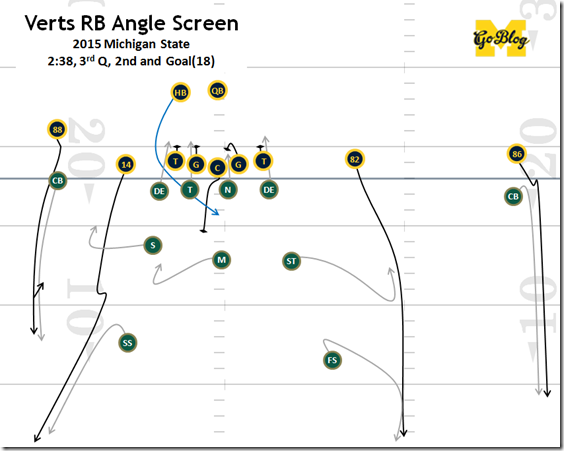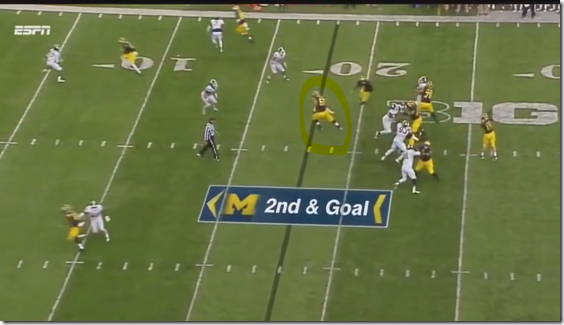In the Kindle Edition of HTTV for this year (oh by the way that exists) I added a sidebar/article on Michigan State's defense and different ways to attack it. With Quarters coming back into vogue to combat the spread, and Quarters teams getting super-aggressive against the run, offenses have been pulling the old Spurrier trips-and-triangle stuff to attack it. But Quarters is not new, and there are some other good answers out there for an overzealous defense from the two-back offenses that dominated the '80s and '90s.
Here's an oldie but a goodie, the Tunnel (or Jailbreak) Screen to a running back:
A-Train motioned out to the flat, essentially becoming a receiver. Chris Floyd stayed in as an Ace back, then he drifted out the other way to draw people away from where Thomas is going. DeBord caught the Buckeyes in one of TENUTA!!!!'s crazy blitzes that overloaded the backside. The running backs flying out horizontally pulled the linebackers out of the middle. Then Thomas cut back in, and by the time the outside guys can react to that there's an A-Train a-comin' with a lead blocker. It's a race between him and the flat defender for ALL the yards. Flat guy won.
(And Tuman got away with a hold).
This play never went away; they run tunnel screens out of spreads all the time with receivers coming in. Whereas bubble screens attack the defense in the space outside, tunnel screens get the defense moving hard one way to defend the edge, then pass it to a good athlete coming the opposite direction. Like a cutback run, if the screen target can accelerate downfield before the defenders can reverse momentum and converge, it could be a huge gain.
DeBord brought that out in '97 because OSU was blitzing guys off the edge. In 2011 vs MSU Borges (unsuccessfully since he didn't have the personnel) tried to make it a hot read to Vincent Smith. It's particularly good to run against a defense that's getting upfield too aggressively and dropping other guys back, since it attacks the space between them. As you might have guessed, if you catch the linebackers blitzing too that space could be huge, which is why this is fun to run on passing downs.
* [Moore was technically a free safety in '97 but the way OSU played twins this game was to have the CBs follow their receivers and leave Moore the strong side overhang DB.]
[After the jump: Harbaugh's version]
SPREADING IT OUT FOR STATE
Harbaugh brought it out against MSU last year and it would have hit big if it wasn't batted:
In the 1997 example you can see how the DL hurt themselves by getting upfield and the LBS cleared out of the middle. Michigan State's defense is all about getting those DL upfield, but getting LBs out of the center is a problem; they are naturally aligned with small, short LB zones in your favorite running lanes.
But they do have to get wide for four verts. Quarters coverage solved the problem that plagued both Cov 2 and Cov 3 zones: if four receivers go deep one of them will be open. They did that by having the safeties read the inside receivers and play on top (Cover 4) if they go vertical, and default back to Cover 2 if they don't. Then they brought the safeties down, like 10 yards off the line of scrimmage and stepping down at the snap to put a lot of guys in the box. That also meant the safeties would be there for a quick seam. However that also means those safeties could get run by if that inside receiver gets upfield too fast.
So on passing downs they keep those safeties high and cover the quick seam the old fashioned way: have your linebackers get wide. Like so:
The LBs have zones underneath if the RB comes out of the backfield; if he goes into the flat or on a wheel route the SAM will take him; if he cuts inside, the MLB is right on top of him to tackle after a short gain.
Unless…
…wait, a BLOCKER? HERE? At the point of the pass Glasgow isn't even past the line of scrimmage—that's how deep the DL have pushed and the four OL have given ground. The MLB went out to the edge of his zone because Smith was going that direction, and it's coordinated so perfectly that the moment the MLB sees Smith cutting back inside is the same moment Glasgow is setting up to seal that dude from the hole he's supposed to be covering. And with the DBs all playing Cover 4 like good little Quarters'ers there's a ton of room for Smith to outrun the unblocked flat defender and get within rumblin' distance of the goal line before the DBs can zero in.
Then it gets batted by a random lucky swat. Such was the disposition of our universe that day.
Let's watch it to Oblivion music in slo-mo.
Things and Stuff
This is a Scissors play, i.e. it's a counter to the defense selling out against a pass. On a normal down against normal quarters this play is going into the teeth of MSU's defense. State will normally pack this area with linebackers so much that offenses don't even bother attacking them there. That's why their Double-A gaps blitz works so well; the last place the opponent is likely to be throwing is where the defense just evacuated (and there are safeties around to hold it down if that happens). Passing down defense is the same idea: they use their own tendency to create a tendency they can exploit. This little RB screen is a good way to break the cycle.
Design-wise the play is hardly different from four verts (with the traditional Harbaugh outlets planned into at least one route). Verts often has a RB leaking out either on a swing or angling like this under the coverage, since an emergency pass to any of the four downfield receivers would be a dangerous prospect. Except this play flips that narrative; the receivers going deep draw off the coverage and the leaking RB pass is the main thing, set up by the center trundling downfield. Harbaugh took the skeleton of the world's greatest "go long" play that's designed to force you to throw to the running back, and turned it into an old fashioned anti-blitz screen.
The cool thing is it retains that anti-blitz property. Had Michigan caught them in the double-A gaps blitz here then Glasgow doesn't even have to work downfield to get his block; he can delay, then slip by the blitzers and escort his back down the field. The QB just has to get it out before the rush hits home.
And over the DL's arms. Natch. Ah well, I bet we'll see it again.


